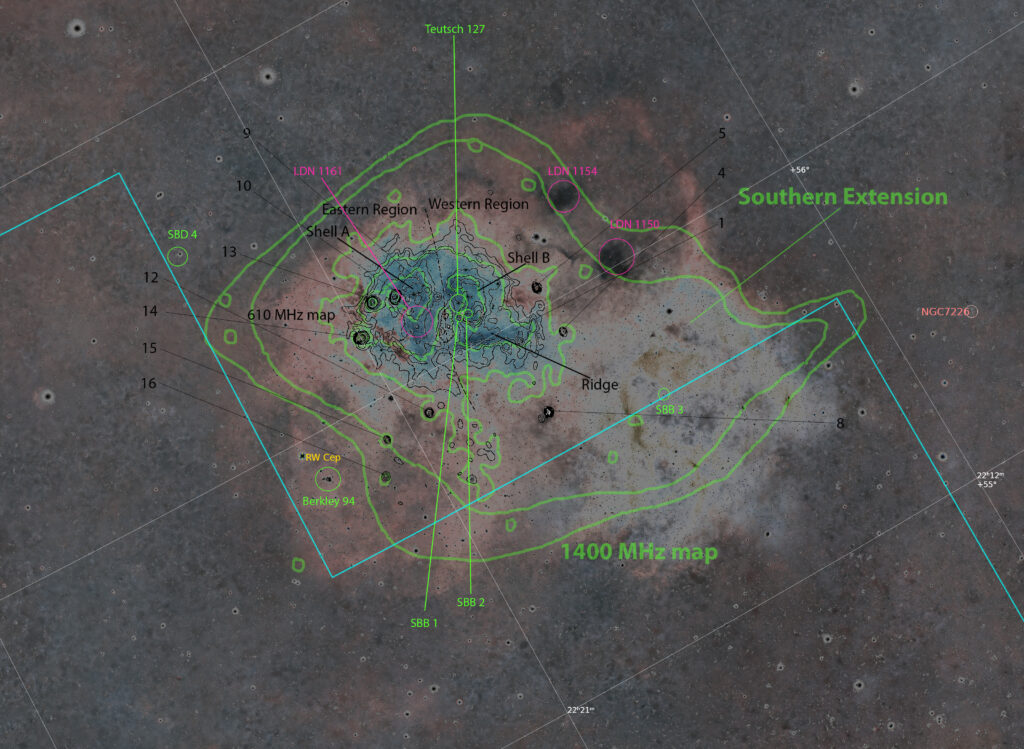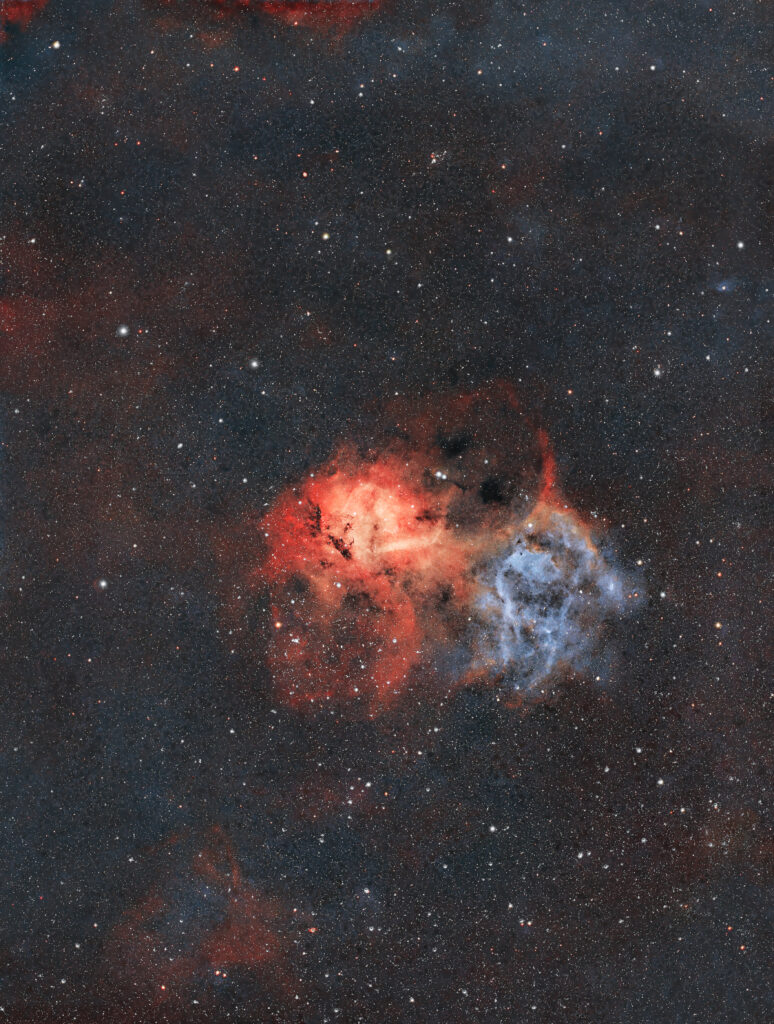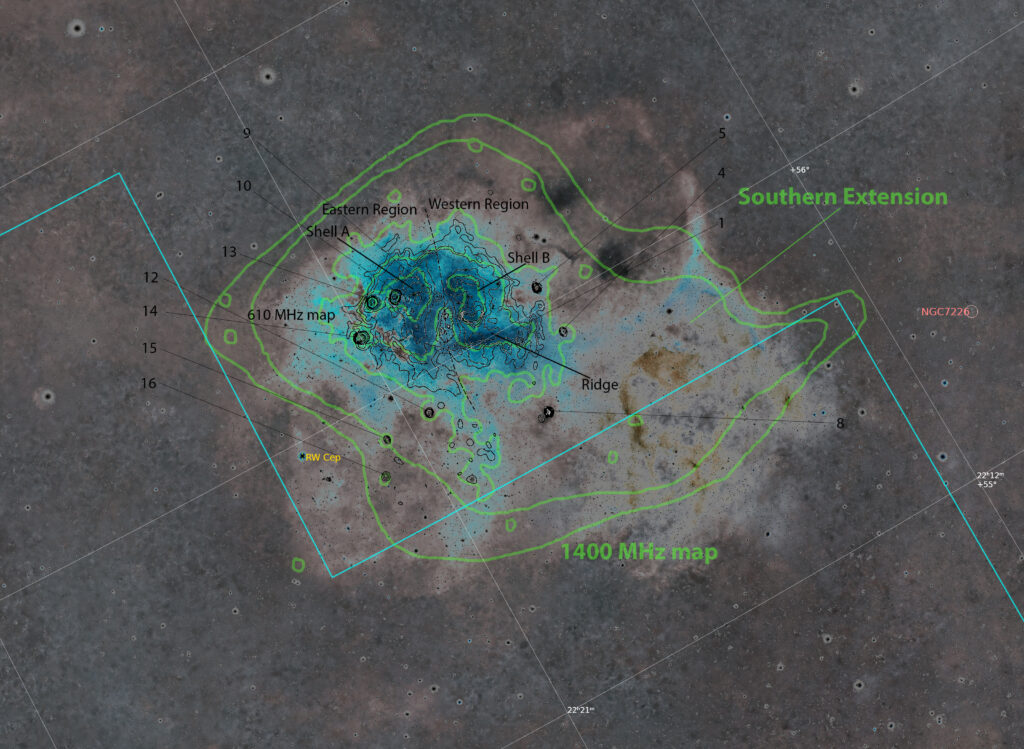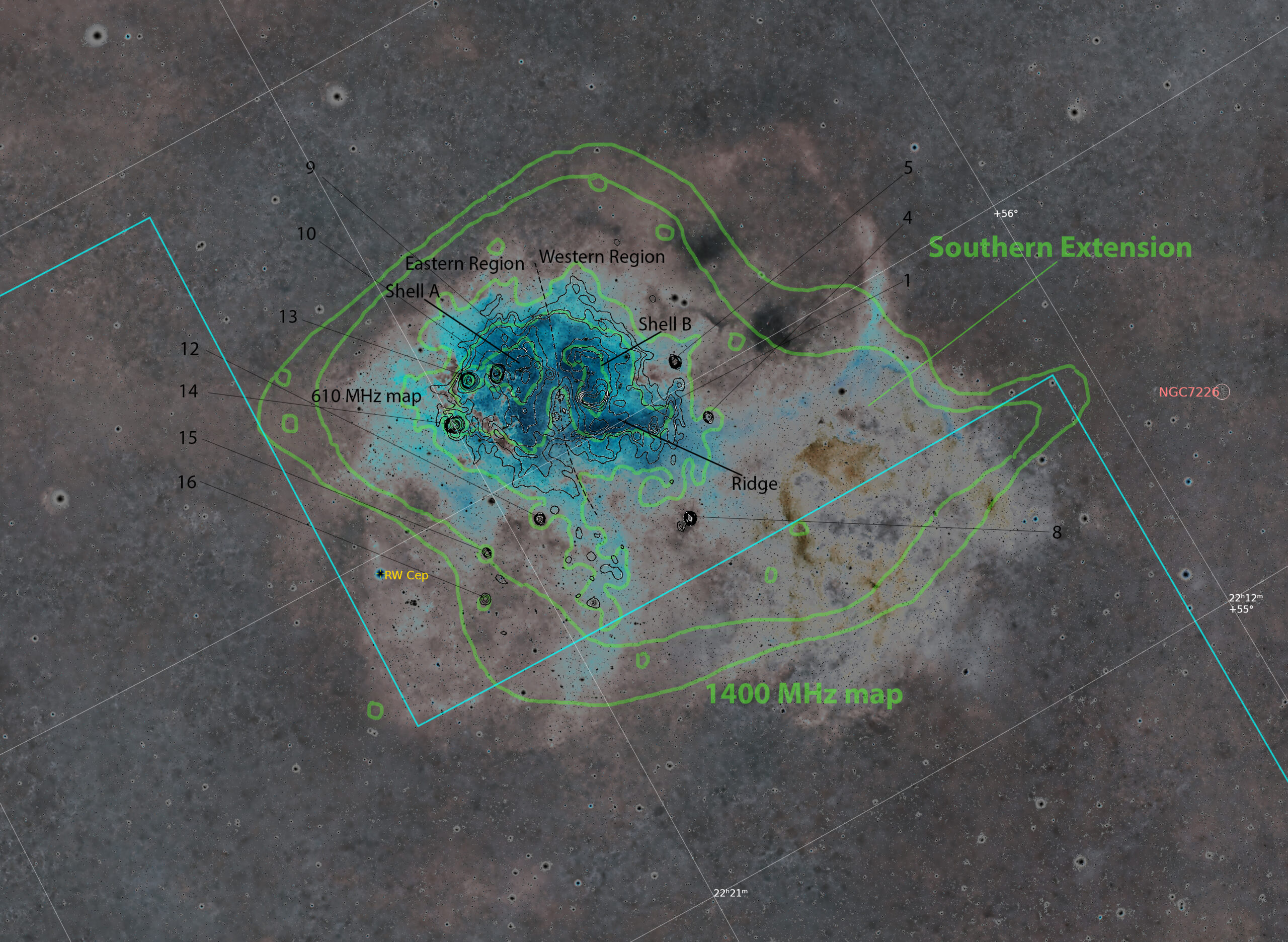
Astrobin: https://www.astrobin.com/jm0j9e/B/
Photoshop master file available here: https://e.pcloud.link/publink/show?code=XZBgeBZiipzDUvNC9yRE5unT8WlQybzU5fy
According to Stewart Sharpless annotation, 1959 “A Catalogue of Hii Regions” U.S. Naval Observatory, 10 Sept. 1959 [ https://articles.adsabs.harvard.edu/pdf/1959ApJS….4..257S ], Sh2-139 is “Part of II Cep association” a wide and luminous OB spectral type stellar association situated at a distance of about 3.200 parsec, or 10.400 light years, within the Perseus Arm, one of the 2 major spiral arms of our galaxy.
Cfr.: Churchwell Ed, Babler Brian L., Meade Marlin A. 2009 “The Spitzer/GLIMPSE Surveys: A New View of the Milky Way” Publications of the Astronomical Society of the Pacific. 121: 213–230. https://ui.adsabs.harvard.edu/abs/2009PASP..121..213C/abstract

Sh2-132 complex is featured by a bright optical nebula with an intense central region (Ø = 25’) surrounded by more diffuse emission ( Ø ~ 1*). Low resolution radio studies have shown it to be an intense radio source with a strong central core contained into a more diffuse envelope.
Churchwell and Walmsley 1973 analysis confined that the total emission is thermal nature, featured by a spectrum flatted down to 0.408 GHz, typical of a low Hii density region.
Cfr. Churchwell E. , Walmsley C. M. , 1973 “Observation of Optical Nebula at 2695 Mhz ” in Astron. Astrophys. 23: 117
Nebula analysis shows two distinct regions separated by an area, running from NW to SE, with little or no emission.
The optical emission in the eastern region is quite mottled, with areas of bright emission and patches of obscuring materials. Western region is instead featured by little or no obscuring matter.
According to Lynds 1962 Catalogue of Dark Nebulae there are three main dark nebulae classified as LDN 1150, LDN 1154 and LDN 1162; Cfr. https://heasarc.gsfc.nasa.gov/W3Browse/nebula-catalog/ldn.html
Strong central features and western/eastern regions strong/weaker emission are confirmed by radio analysis at 0.408 GHz and 1.4 GHz conducted respectively by Felli et al. 1977a and Felli and Churchwell 1972.

According to Van der Hucht 2001 and Hamman et al. 2006 among those very hot and massive stars responsible for the ionization of gasses, notable consideration have to be taken about two Wolf-Rayet subjects, known as HD 211564 and HD 211853 (or WR 153), featured by a huge bubble well visible in radio emissions identified as Shell B, which scholars suggest to be originated from strong stellar wind from these massive star, featured after Harten et al. 1978 study by a non uniform emission specially on the eastern side where there is essentially no emission at all.
Similar smaller structure, named Shell A, bubbles around a class K star.
Cfr. Van der Hucht K. A. , 2001 “VizieR Online Data Catalog: 7th Catalog of Galactic Wolf-Rayet stars” in NewAR,45, 135. https://ui.adsabs.harvard.edu/abs/2001yCat.3215….0V/abstract
Hamann W. R., Gräfener G. , Liermann A. , 2006 A&A,70, 205. https://ui.adsabs.harvard.edu/abs/2006A%26A…457.1015H/abstract
According to Dubout-Crillon 1976 catalogue, lion’s bottom and tail shaped like portion is made by a thin strip of emission extending to the south of the eastern region featured by a faint Halpha ridge.
Cfr. Dubout-Crillon R. 1976 “H II regions of the northern Milky Way: medium-large-field photographic atlas and catalogue” in Astronomy and Astrophysics, Suppl. Ser., Vol. 25, p. 25 – 54. https://adsabs.harvard.edu/full/1976A%26AS…25…25D
According to Avedisova 2002 it is plausible to hypothesize that this nebula was setting of some chain processes of star origin.
Avedisova, V. S., A Catalog of Star-Forming Regions in the Galaxy, in Astronomy Reports, vol. 46, n. 3, marzo 2002, pp. 193-205. https://ui.adsabs.harvard.edu/abs/2002ARep…46..193A/abstract
Harten et al. 1978 studies of radio emission of this Hii region results indicated that 2/3 of the radio emissions originates in features larger then 10’ in diameter, suggesting that total mass and low electron density placed Sh2-132 as a member of evolved giant Hii region.
Helou and Walker studies of infrared sources identified and cataloged within the nebula nine sources of infrared radiation, while Wouterloot and colleagues 2013 identified an H2O maser source.
Helou, George; Walker, D. W., Infrared astronomical satellite (IRAS) catalogs and atlases. Volume 7: The small scale structure catalog, in Infrared astronomical satellite (IRAS) catalogs and atlases, vol. 7, 1988, pp. 1-265. https://ui.adsabs.harvard.edu/abs/1988iras….7…..H/abstract
Wouterloot, J. G. A.; Brand, J.; Fiegle, K., IRAS sources beyond the solar circle. III – Observations of H2O, OH, CH3OH and CO, in Astronomy and Astrophysics Supplement Series, vol. 98, n. 3, maggio 1993, pp. 589-636. URL consultato il 21 marzo 2013. https://ui.adsabs.harvard.edu/abs/1993A%26AS…98..589W/abstract
The development of infrared astronomy gives chances to scholars like Saurin and colleagues 2009 to explore Sh2-132 Hii regions and studied its Hii region as a star forming region and embedded star clusters complex.
Grounding on Harten et al. 1978 radio continuum emission as indication of giant nature of this complex and its evolved character, Saurin hypothesized that Sh-132 could be suitable laboratory for early dynamical and hydrodynamical evolution, and by R-band Digitalized Sky Survey imaging of the whole complex they confirm 2 previous identified open cluster

- Teutsch 127a – optical embedded open cluster, includes Trap 900
- and Berkley 94a – optical open cluster on the outskirts of the complex
And discovered 4 new open cluster:
- SBB1 – infrared embedded cluster with IRAS 22172+5549,
- SBB2 – optical embedded cluster with bow-shock
- SBB3 – Compact optical open cluster surrounding WR 152
- SBB4 – Optical open cluster on the outskirts of the complex.
Cfr. Saurin T. A. , Bica E. , Bonatto C. , 2010 “Star clusters in the Sh2-132 complex: clues about the connection between embedded and open clusters” in journal of Royal Astronomical Society, 407, 133-143 (2010) https://academic.oup.com/mnras/article-pdf/407/1/133/3067396/mnras0407-0133.pdf

